|
|
| Line 157: |
Line 157: |
| | === "Options" Tab === | | === "Options" Tab === |
| | | | |
| − | {| cellspacing="1" cellpadding="1" border="1" style="width: 459px; height: 303px;" class="wikitable" | + | {| cellspacing="1" cellpadding="1" border="1" class="wikitable" style="width: 459px; height: 303px;" |
| | |- | | |- |
| | | colspan="2" | [[Image:Analysis Summary 007.png]] | | | colspan="2" | [[Image:Analysis Summary 007.png]] |
| Line 172: |
Line 172: |
| | | | |
| | | width="50%" | | | | width="50%" | |
| − | '''<span style="color: rgb(255, 0, 0);">K: </span>'''If this option is checked, the database exports the summary following an existing '''''Excel''''' file. | + | '''<span style="color: rgb(255, 0, 0);">K: </span>'''If this option is checked, the database exports the summary following an existing '''''Excel''''' file. By default, the system adds the summary to the last created file.<br> |
| | | | |
| | |} | | |} |
Revision as of 13:32, 29 August 2011
Template:Header ProDon
Introduction
The "Analysis and history" management contains all the transacions of the database. It is common to wish to highlight information for analysis purposes. Many of these analyses are possible thanks to the summaries available. For example:
- How many different clients were there for the 1,000 transactions of a targeted donation occasion?
- What is the distribution per city of these 1,000 transactions?
- What is the total amount of all the transactions of a targeted year?
- ...
Viewing Summaries
The summaries are always calculated based on the active list. The active list is the result of a search or a filter. For instance, if you want to compare the information of several editions of golf tournaments, you first have to conduct a search. This search allows you to view, onscreen only, the transactions attached to one of the golf tournaments. It is possible to search using the search bar or by making a filter.
When the search is done, click on the  button at the top of "Analysis and history", to display the summaries.
button at the top of "Analysis and history", to display the summaries.
|
After clicking on the  button, the management grid splits into two sections. button, the management grid splits into two sections.
|
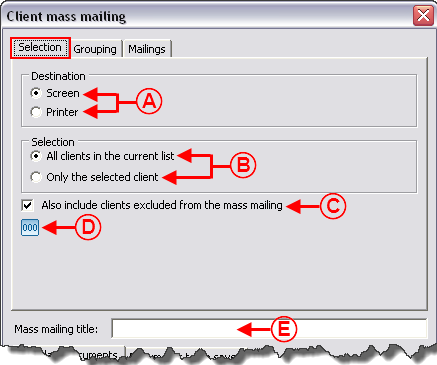
|
|
A: The top part contains the active list.
|
B: The bottom part allows you to select the analysis summary.
|
|
The section of the summary presents three elements.
|
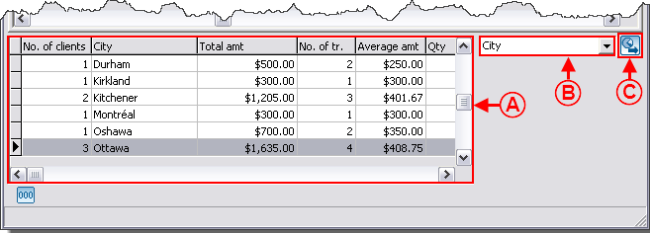
|
|
A: It is the result of the summary.
|
B: This drop-down list allows you to choose the type of summary that will be displayed in A.
|
|
C: This button allows you to export data to Excel.
|
|
|
Certain summaries require additional information.
|
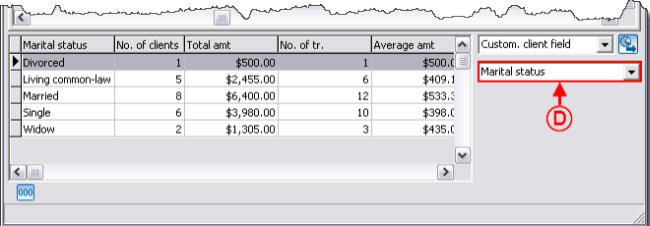
|
|
D: This option depends on the type of summary selected in B. For instance, to use the "Custom. client field", which means "Customized client field", you must choose the name of the field on which the summary will be made. In this example, the "Marital status" field has been selected.
|
NOTE: There are several types of options: for characteristics and customized fields summaries, you have to choose the field or the characteristic proper to the summary to produce. For a date summary, there are two options to check: the period of the summary (year, month or day) and if the summary is based on the transaction date or on the deposit date. For all the other types of summaries, there is no additional option to select.
|
Exporting Summaries to Excel
It is possible to export the result of the summary using the  button.
button.
"Summaries" Tab
|
After clicking on the  button, this window opens in order to configure the exportation to Excel. button, this window opens in order to configure the exportation to Excel.
|
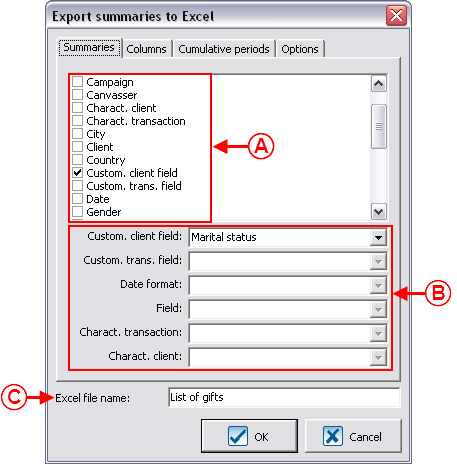
|
|
A: First indicate which summaries should be exported to Excel. By default, the summary previously chosen is already checked. However, it is possible to export many summaries at the same time.
|
B: This section allows you to specify the complementary information to bring to the characteristics, customized fields or date summaries. By default, if none of the summaries requiring a specification has been checked, all the fields are shaded. As soon as a field requiring a specification is checked in A, the lines necessary to the specification are released.
|
|
C: To export to Excel, the database creates and names a file in the computer. It is therefore possible to modify the name.
|
|
"Columns" Tab
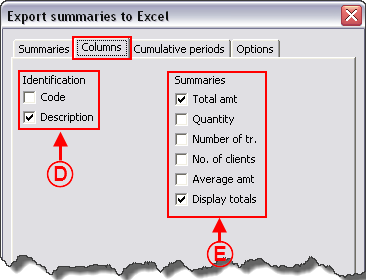
|
|
D: The "Identification" section allows you to indicate the type of summary and its code.
Here are two examples:
- For a summary by city, the description is the name of the city and there is no code.
- For a summary by donation occasion, the description is the name of the donation occasion and the code is the same as the donation occasion's.
|
E: The "Summaries" section allows you to indicate which amounts will be exported to Excel.
|
|
NOTE: These options are the same for all types of summaries, except for the following four: "Client", "Third-party client", "Linked to (1)" and "Linked to (2)". In these four cases, the fields relating to clients are added under "Identification".
|
"Cumulative periods" Tab
|
This tab allows you to make summaries on precise periods. Each checked period adds a column per "Summary" checked in the "Columns" tab.
For more details concerning period management, consult this document.
|
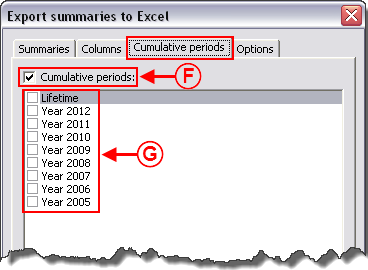
|
|
F: This box must be checked so that the periods in G become accessible. If this box is not checked, the periods are shaded.
|
G: These are all the periods present in the database. To know how to create new ones, consult the "Period management" procedure.
|
"Options" Tab
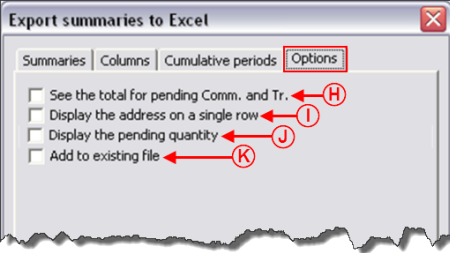
|
|
H: This option is only used with the summary by occasion. It displays the current total for pending commitments and transactions separately from the total of the filtered transactions onscreen.
|
I: If an address is written on two lines, by checking this box, both lines become one in order to view the complete address in the Excel cell.
|
|
J: This option is only used in the "Articles" tab of "Analysis and history" and allows you to calculate the quantity of articles present in the pending transactions.
|
K: If this option is checked, the database exports the summary following an existing Excel file. By default, the system adds the summary to the last created file.
|
Excel Functions on Summaries
The Excel functions can lead to misinterpretations if they are misused. Here is an example of common error:
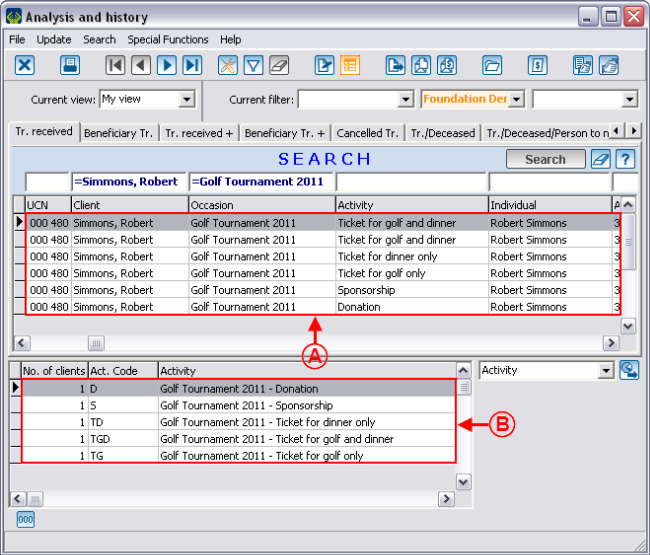
|
|
A: You are looking for a client and a precise occasion. The client has made several donations for different activities in this occasion.
|
B: In the summary, each activity presents to you the number of clients who have made a donation. There is only one client for each activity and he is always the same one.
|
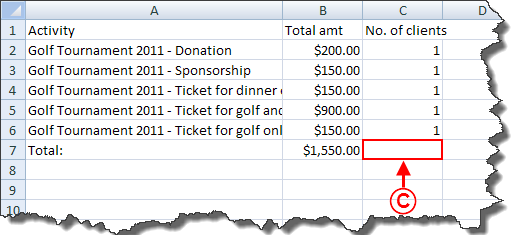
|
|
C: In Excel, if you make the total at line 7 of column C (number of clients), the result would be 5, while there is only client (see point A).
|
Document name: ProDon:Analysis Summary
![]() button at the top of "Analysis and history", to display the summaries.
button at the top of "Analysis and history", to display the summaries.
![]() button.
button.






